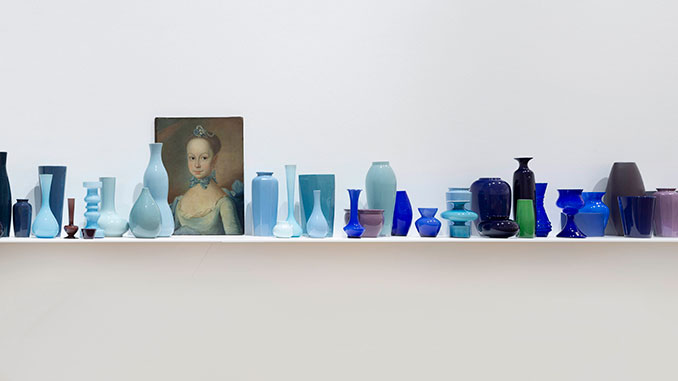 UNSW Galleries marks 10 years with the opening of Renee So: Provenance and David Sequeira: History & Infinity from 18 August – 19 November 2023.
UNSW Galleries marks 10 years with the opening of Renee So: Provenance and David Sequeira: History & Infinity from 18 August – 19 November 2023.
UNSW Galleries is celebrating a decade of exhibition-making since its opening in August 2013. Building on the legacy of Ivan Dougherty Gallery (1977–2009) led by the late Nick Waterlow OAM, UNSW Galleries has cemented its position as a leading university art museum dedicated to supporting practitioners and pushing the boundaries of creative practice and social discourse.
Since its inception, UNSW Galleries has supported over 1000 artists, designers, curators, and writers across 100 exhibition projects, and welcomed over 200,000 visitors through its doors.
To celebrate these achievements, UNSW Galleries is delighted to present two major exhibitions by renowned Australian artists, Renee So and David Sequeira. These projects underscore the gallery’s commitment to cultivating close relationships within the University Art Museums Australia network.
Together, they exemplify the critical role of the university gallery in commissioning and showcasing Australia’s most exciting and innovative mid-career artists.
“Collaboration across the university museum sector has enabled us to explore the intersection of research excellence, interdisciplinary exchange, and community knowledge,” said UNSW Galleries Director, José Da Silva.
“In our tenth year we’re taking the opportunity to reflect on past accomplishments and imagine a future that places artists and designers at the forefront of exhibition-making.”
Renee So: Provenance
Provenance is the first significant survey exhibition of London-based artist Renee So. Co-presented with Monash University Art Museum, the exhibition is curated by Charlotte Day, Associate Director, Art Museums at the University of Melbourne.
This extensive survey combines a decade of So’s ceramic sculptures and ‘knitted paintings’, playfully engaging with art history, museum collections, and popular forms of gendered symbolism. Embracing traditional craft methods and cross-cultural thinking, the project speaks to So’s journey from Hong Kong to Melbourne, where she was raised, before relocating to London in 2005.
So’s early works establish an affinity for the history and materiality of earthenware and textiles to explore archetypes of male authority. From full bellies and boots to the bearded faces of 16th- and 17th-century German Bellarmine jugs first encountered in London’s Victoria & Albert Museum, So consistently returns to museum objects as a source of inspiration. The exhibition title Provenance calls into question the politics surrounding the ‘acquisition’ of cultural objects into museum collections in a sharp critique of elginism and colonisation.
In recent work and new commissions, So increasingly looks toward representations of feminine forms, drawing on prehistoric and contemporary artistic precedents. Works reference classical sculpture, Venus figurines dating between 40,000–10,000 BCE, alongside new visualisations of the clitoris developed by Australian urologist Helen O’Connell. Provenance is distinguished by an underlying sense of the comedic and persistent feminist worldview, constructing one narrative among many throughout So’s idiosyncratic practice.
 David Sequeira: History & Infinity
David Sequeira: History & Infinity
Disrupting and rethinking the narratives of art has been a foundational strategy over the past three decades for celebrated artist, curator, and academic David Sequeira. History & Infinity combines three significant works employing languages of colour, space, and geometry to articulate relationships between personal and universal experiences.
Sequeira is a Senior Lecturer at the Victorian College of the Arts and Director of the Fiona and Sidney Myer Gallery. Working at the intersection of exhibition-making and artistic practice, he uses curatorship as an expanded studio technique to rethink how we understand identity, values, and cultural production.
The exhibition centres around History and Infinity 2022, an expansive shelf-based installation comprising over 1000 discarded glass and ceramic vases punctuated by a selection of paintings by other artists referencing colonialism, modernism, postmodernism, creation stories, and baroque portraiture. Sequeira describes the arrangement as ‘chromatic harmonies’, formed by shifting gradients of colour that span the length of each gallery wall.
Sequeira’s interest in the relationship between colour and music is an enduring theme throughout his practice. Symphonic Poem 2014 is a sequence of 48 works on music manuscripts that emphasise the visual resonance and vibration of colour through tonal variation and repeated geometric forms.
Sequeira’s new visual score, The ocean refuses no river 2023, combines intensely coloured diagrammatic forms with ocean imagery. Arranged on music stands as an imagined set for a choir or chamber orchestra, Sequeira continues his pursuit of infinity through a continuous harmonic, the sum of which is infinitely greater than its components.
With the launch of these two projects, UNSW Galleries continues its commitment to support Australian practitioners through a dynamic program of exhibitions, commissions, publications, and touring initiatives.
Renee So: Provenance | David Sequeira: History & Infinity
UNSW Galleries, Corner Oxford Street and Greens Road, Paddington
Exhibition: 18 August – 19 November 2023
Free entry
For more information, visit: www.artdesign.unsw.edu.au for details.
Images: Renee So, ‘Opium’ Snuff Bottle, 2022; ‘Snuff’ Snuff Bottle, 2022; ‘Poison’ Snuff Bottle, 2022; Imperial Pekingese Dog, 2022; and ‘Colony’ Snuff Bottle, 2022. Installation view: Monash University Museum of Art, Melbourne, 2023 – photo by Andrew Curtis | David Sequeira, History and Infinity (detail) 2022. Discarded glass and ceramic vases, with painting inset by unknown artist, ‘not titled’, c.1750, France. Installation view: Bunjil Place, Melbourne, 2022 – photo by Christian Capurro
